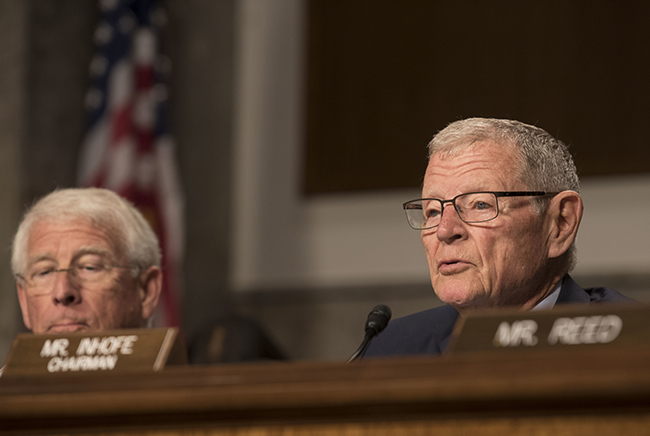
Sen. James Inhofe, chairman of the Senate Armed Services Committee, delivers remarks at the July 24, 2019, confirmation hearing for Under Secretary of Defense (Comptroller) / Chief Financial Officer David Norquist to be deputy defense secretary in Washington, D.C. Defense Department photo by Lisa Ferdinando.
Faced with the House and Senate’s inability to agree on key tenets of an annual defense policy bill, Sen. Jim Inhofe (R-Okla.) on Oct. 29 introduced a “skinny” version of the 2020 National Defense Authorization Act that aims to put the most important pieces into law while lawmakers continue debating stickier points.
The skinny NDAA would allow troops and civilians to get paid, and allow for child care and other services for military families. It would also extend the authorities that combat troops need to fight the Islamic State group, al-Qaida, and the Taliban, allow for military construction and acquisition oversight, and sustain readiness.
“The committee went line-by-line to find the must-haves and worked with the Department of Defense closely to ensure the military has all it needs to support our troops and succeed in our missions,” a Republican staffer said. “It is not intended to be the only NDAA Congress considers this year.”
Inhofe, who chairs the Senate Armed Services Committee, said in a speech on the chamber floor that the notion that Congress can’t get a compromise NDAA across the finish line is an “ugly rumor.” Despite ongoing challenges, he voiced confidence that Congress can continue its nearly 60-year streak of passing the NDAA in a bipartisan manner.
“People put more and more things on the bill. Many things have nothing to do with the military because they know that the bill is going to pass,” Inhofe said. “Consequently, there are so many people lined up with different things they want put on the defense authorization bill that we have not been able to come to an agreement.”
Lawmakers have tried to work through a slew of differences over nuclear weapons, border security, and spending limits, among others. The more limited policy bill would act as a stopgap measure if the full NDAA does not pass. House and Senate members formally began the process of creating a conference bill in mid-September.
Rep. Adam Smith (D-Wash.), head of the House Armed Services Committee, said Oct. 24 that any bill that does not restrict funding for a wall along the southern US border “would be challenging to bring to the House floor.”
“As our conferees continue to work through the differences between the House and Senate versions of the FY-20 NDAA, there is one major sticking point: How to address the President’s use of Department of Defense funds for a border wall,” Smith said in a release. “However, this sticking point is no different than those in years past. Inevitably we have policy disagreements as we draft our bill each year, but for the last 58 consecutive years, the Congress has successfully negotiated and reconciled these differences for the better of our nation.”
Lawmakers are still working on the appropriations aspect as well. If Congress fails to pass a 2020 defense spending bill, Inhofe added, the financial impact on the Pentagon would total around $22 billion in program delays and more.
